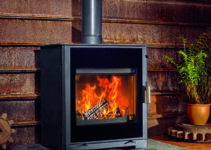As someone who has experienced the warmth and cosiness that a log burner brings to a home, I understand the importance of having a fully functional wood stove. My objective today is to impart knowledge on ensuring a tight seal log burner door. It’s the small details, such as the condition of the door seal, that play a critical role in the performance and efficiency of your stove. In this section, I’ll discuss the significance of maintaining this aspect and how wood stove accessories are integral to your stove’s maintenance.
One common issue I’ve come across is how an old or worn-out gasket on the log burner door can negatively impact the stove’s operation. Addressing this does not necessarily mean an expensive repair or professional service; with the right tools and methods, stove maintenance can be a straightforward and satisfying DIY task. I’ll guide you through creating an airtight seal that keeps the warmth in and the cold out efficiently.
Keep an eye out for more detailed steps in the following sections, where I’ll delve deeper into practical advice for identifying when your seal needs attention and choosing the correct materials for a durable and high-performing wood stove door.
The Importance of Maintaining a Tight Seal on Log Burner Doors
Maintaining a steadfast focus on the integrity of your log burner’s door seal can radically transform the ambiance and warmth of your home. Beyond mere comfort, a tight seal is intrinsically linked to the heating efficiency of your fireplace, while also rigorously guarding against unnecessary energy loss.
Impact on Heating Efficiency and Airflow Control
When I address the health of my fireplace’s gasket, I’m confronting the core of stove maintenance. The seal dictates the mastery I hold over the fire’s intensity; the tighter the seal, the more precise the airflow control, ensuring optimum combustion and heating efficiency. Regular inspections and prompt maintenance of the fibreglass gasket minimise heat escape, empower me to wield control over the temperature within, and bolster the stove’s performance.
Reducing Smoke Emissions and Maximising Burn Time
It’s not just about maintaining warm toes on a chilly evening; a rigorous seal ensures smoke emissions are kept at bay, preserving the air quality within my living space. Furthermore, a well-sealed log burner significantly stretches the burn time of logs, curating an economic and environmentally responsible burn. This judicious approach to fuel consumption speaks directly to a larger narrative of sustainability and cost-efficiency.
Signs Indicating a Compromised Door Seal
I remain vigilant for tell-tale signs that suggest a seal’s integrity might be compromised. While discolouration is a natural age-indicator and not an immediate cause for alarm, the rubber-hardening and brittleness of the fibreglass material are stark indicators that the time has come for replacement. These symptoms can drastically undercut the meticulous control I seek in my stove’s performance, compelling a timely response.
- Regular inspection of door seal for signs of wear.
- Prompt replacement of the fibreglass gasket to retain a tight seal.
- Meticulous stove maintenance to enhance heating efficiency.
Committing to these practices encapsulates an investment into the efficiency and longevity of my fireplace, weaving into the narrative of my home a tale of warmth and efficiency, diligently powered by the stewardship of a tight seal on my log burner door.
Ensuring Tight Seal Log Burner Door – Step by Step Replacement Guide
As a homeowner passionate about DIY woodstove maintenance, I recognise that maintaining a tight seal on your wood burning stove is fundamental to its performance. In this guide, I’ll take you through the meticulous process of replacing the log burner door seal, which, while straightforward, can vastly improve your stove’s efficiency.
The initial phase involves the removal of the weathered door gasket. Begin by gently extracting the fibreglass rope from the groove, ensuring no pieces are left behind. A putty knife proves invaluable at this stage to scrape away any adhesive residue, setting the scene for a pristine installation.
- Measure the gasket channel meticulously, ensuring the new gasket sits without tension. Remember, even minor errors can compromise the efficacy of the tight seal.
- Apply high-temperature adhesive liberally along the cleaned groove; this serves as the bedrock for the new fibreglass rope.
- Align the fresh gasket accurately within the channel, confirming its fit before the adhesive sets.
- Upon positioning the rope, I typically close the door to encourage a uniform seal while the glue cures.
Checking the extant gasket regularly for signs of wear, such as brittleness, informs me of the timing for these DIY interventions. A seamless fit is essential, and as such, I devote attention to cutting the gasket rope to the exact length required, taping the ends to sidestep fraying.
| Step | Action | Tools Needed |
|---|---|---|
| 1 | Gasket Removal | Putty knife, gloves |
| 2 | Clean Groove | Putty knife, vacuum cleaner |
| 3 | Measure Gasket | Tape measure, new fibreglass rope |
| 4 | Apply Adhesive | High-temperature glue, caulk gun (if required) |
| 5 | Place New Gasket | Gloves, scissors to cut the rope |
| 6 | Test Seal | Dollar bill |
In my experience, conducting the ‘dollar bill test’, by placing a bill between the door and stove while closing it, and pulling gently to feel resistance, verifies the integrity of the replacement work, confirming a tight seal has been achieved.
Ultimately, sound maintenance is key to the long-term performance of any wood burning stove, and attending to the log burner door seal should not be underestimated.
Identifying When Your Wood Stove Door Gasket Needs Attention
Maintaining a tight seal is crucial for the efficient performance of your wood burner. The gasket seals the door to prevent air leaks, which can affect combustion and heat retention. In my experience, attentive wood burner door maintenance is essential to not only extend the door seal lifespan but also to ensure the safety and fireplace maintenance as a whole.
Discoloration and brittle textures may ring alarm bells, yet they’re not definitive signs that a door gasket needs to be replaced. Let’s delve into how you can accurately identify the need for maintenance or replacement.
Discoloration and Brittleness: Not Always Indicators for Replacement
While discolouration and a once-supple gasket turning brittle might suggest deterioration, these characteristics aren’t reliable indicators for immediate replacement. A gasket can darken due to the stove’s exposure to intense heat over time, yet retain its effectiveness. Therefore, I recommend close inspection and regular servicing rather than relying on visual signs alone.
Testing for Air Leaks with the Matchstick Method
I have found the matchstick method to be incredibly insightful – light a matchstick and pass it slowly around the door perimeter. If the smoke is drawn in or disrupted, it suggests an air leak, signifying the need for gasket maintenance or replacement.
Lifespan of a Wood Stove Door Seal and Replacement Frequency
Typically, a wood stove door seal should last through several seasons; however, its lifespan will be determined by multiple factors, including the stove model, usage frequency, and heat intensity. Here’s a table outlining potential replacement intervals:
| Seal Condition | Description | Recommended Action |
|---|---|---|
| Current Seal | Firm to the touch, light discolouration | Regular monitoring, no immediate action needed |
| Brittle/Hardened Seal | Easily crumbles, evident air leaks | Replacement recommended |
| Blackened Seal | Darkened due to heat, maintains elasticity | Visual inspection, perform matchstick test |
It’s prudent to refer to the manufacturer’s guidelines for the door seal lifespan and undertake the suggested maintenance to ensure a tight seal and optimal operation of your wood burner.
Choosing the Right Materials for Your Wood Stove Door Seal
When it comes to ensuring a high-performance seal for your wood stove door, selecting the correct materials is paramount. For anyone with a wood stove, the integrity of the door seal is critical for maintaining the unit’s efficiency and safety. Through my extensive experience, I’ve found that a fibreglass rope gasket not only offers superior high-temperature resistance but also the essential flexibility needed for proper stove operation. The choices you make here will directly impact the longevity and safety of your wood stove, and as such, deserve careful consideration.
Fibreglass Gasket: The Optimal Material for High-Temperature Resistance
My top recommendation is always a quality fibreglass rope gasket. Known for its ability to withstand intense heat without compromising its structural integrity, fibreglass is the industry standard for a high-temperature seal. When I inspect doors on wood burners, the deterioration of non-fibreglass materials showcases the need for fibreglass’s durability. Plus, due to its inherent flexibility, installing a fibreglass gasket correctly ensures a snug fit, preventing unwanted airflow that can compromise combustion efficiency.
Understanding Gasket Sizes and How to Measure Properly
Ensuring that you have the right size gasket is critical to create an airtight seal. I advise consulting the stove’s manual or directly measuring the gasket groove to achieve a perfect fit. Personally, I measure both the width and depth of the channel and always select a gasket with the larger of the two measurements. This allows for enough material to fill the space adequately, compensating for any irregularities within the channel and promoting a better seal.
Selecting the Best Adhesive for a Lasting Bond
In addition to the gasket itself, the adhesive used is a cornerstone for creating a lasting bond. It must withstand the rigours of high temperatures and frequent stove usage. My years of experience have taught me to choose high-temperature resistant glues designed specifically for wood stove applications. The efficacy of such adhesives ensures that the gasket remains firmly in place, maintaining the integrity of the seal through the seasons. Trust in brands known for their quality, like Clearview and Hunter Stoves, can guide you to adhesives that are not only reliable but also suitable for your specific stove model.



